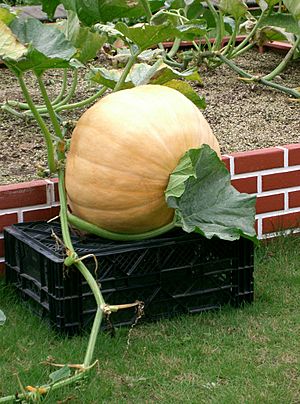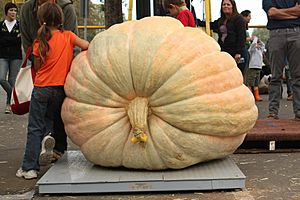Giant pumpkin facts for kids
Imagine a pumpkin so big it looks like it came from a fairy tale! A giant pumpkin is a special kind of orange squash. It's a type of plant called Cucurbita maxima. These amazing fruits can weigh from about 150 pounds (68 kg) to over 2,000 pounds (910 kg)! That's heavier than a small car! People grow them for fun and for exciting competitions.
Contents
Discovering Giant Pumpkins
A Look Back: The History of Giant Pumpkins
The hobby of growing giant pumpkins started in North America. One of the first people to grow a truly big pumpkin was Henry David Thoreau in 1857. His pumpkin weighed about 123 pounds (56 kg)! He even wrote about it.
The first giant pumpkins grown for competition came from William Warnock in Canada. In 1893, his pumpkin weighed 365 pounds (166 kg) at the Chicago World's Fair. He even won a bronze medal at the Paris World's Fair in 1900 for a 400-pound (181 kg) pumpkin! William Warnock shared his secrets, helping others grow huge pumpkins too. His records lasted for about 70 years. Then, people started growing even bigger pumpkins, breaking records often. Today, many giant pumpkin growers are in North America, but some champions come from Europe.
Growing these huge pumpkins has led to other fun activities. People have giant pumpkin boat races and even competitions where they launch pumpkins into the air, called pumpkin chucking. You can often see these amazing pumpkins at local county fairs and special shows.
How Do Giant Pumpkins Grow So Big?
Giant pumpkins are a special type of squash called Cucurbita maxima. This is different from the pumpkins we use for jack-o'-lanterns or pumpkin pies. Those are usually C. pepo. Wild C. maxima squash originally came from South America. They were only about the size of a softball!
The Right Seeds and Soil
People have been growing large pumpkins for a long time. A variety called 'Mammoth' was sold way back in 1834. Most giant pumpkins today come from a special type called 'Dill's Atlantic Giant'. This type was developed by a grower named Howard Dill. Seeds from winning giant pumpkins can be very expensive. Some single seeds have sold for as much as US$850! Growers even keep family trees for their pumpkins, just like for racehorses.
Even though they are huge, giant pumpkins are usually not eaten. They don't taste very good and can be quite watery.
Special Growing Techniques
Giant pumpkins can grow incredibly fast, sometimes gaining up to 50 pounds (23 kg) in just one day! Their cells grow larger than regular pumpkins. They also hold a lot of water, up to 94%. These pumpkins have special genes that let them keep growing and growing.
As they get bigger, giant pumpkins can flatten out under their own weight. They might even form an arch shape on the bottom to help support themselves. Sometimes, they can crack or collapse because they are so heavy and fragile. Moving them is a big challenge! Growers often plant many pumpkins because a cracked pumpkin cannot win a competition.
To grow such massive pumpkins, growers use clever farming methods. They often allow only one pumpkin to grow on each vine. This way, all the plant's energy goes into that single fruit. They also make sure the soil is perfect and protect the plants from pests. Some dedicated growers even give their pumpkins special nutrient-rich fluids directly through the stem, like an IV drip!
Pumpkins grown in places with long daylight hours and cool summers often get bigger. The growing season for giant pumpkins is usually 130 to 140 days. This is longer than the 90 to 120 days for regular pumpkins. Farmers use special tools to check the soil and add the right nutrients. Some even use lots of chicken manure, just like early champion growers did!
Amazing World Records
Since the 1970s, the record for the largest pumpkin has been broken many times. This shows that growers are always finding new ways to make pumpkins even bigger! Scientists believe a perfect pumpkin could grow to an amazing 20,000 pounds (9,072 kg) without breaking. However, other things like too much water too fast can still cause them to crack. Every year, about 10,000 people try to grow a champion pumpkin. Thousands of these make it to official weigh-off events.

| Year | Grower | Country | Weight | Reference |
|---|---|---|---|---|
| 2025 | Ian and Stuart Paton | United Kingdom | 2,819.3 lb (1,278.8 kg) | |
| 2023 | Travis Gienger | United States | 2,749 pounds (1,247 kg) | |
| 2021 | Stefano Cutrupi | Italy | 2,703 pounds (1,226 kg) | |
| 2016 | Mathias Willemijns | Belgium | 2,624.6 pounds (1,190.5 kg) | |
| 2014 | Beni Meier | Switzerland | 2,323.7 lb (1,054.0 kg) | |
| 2013 | Tim Mathison | United States | 2,032 lb (922 kg) | |
| 2012 | Ron Wallace | United States | 2,009 lb (911 kg) | |
| 2011 | Jim and Kelsey Bryson | Canada | 1,818.5 lb (824.9 kg) | |
| 2010 | Chris Stevens | United States | 1,810.5 lb (821.2 kg) | |
| 2009 | Christy Harp | United States | 1,725 lb (782 kg) | |
| 2007 | Joe Jutras | United States | 1,689 lb (766 kg) | |
| 2006 | Ron Wallace | United States | 1,502 lb (681 kg) | [a] |
| 2005 | Larry Checkon | United States | 1,469 lb (666 kg) | [a] |
| 2004 | Al Eaton | Canada | 1,446 lb (656 kg) | [a] |
| 2003 | Steve Daletas | United States | 1,385 lb (628 kg) | [a] |
| 2002 | Charlie Houghton | United States | 1,337.6 lb (607 kg) | [a] |
| 2001 | Geneva Emmons | United States | 1,262 lb (572 kg) | [a] |
| 2000 | Dave Stelts | United States | 1,140 lb (517 kg) | [a] |
| 1999 | Gerry Checkon | United States | 1,131 lb (513 kg) | [a] |
| 1998 | Gary Burke | Canada | 1,092 lb (495 kg) | [a] |
| 1996 | Nathan and Paula Zehr | United States | 1,061 lb (481 kg) | [a] |
| 1994 | Herman Bax | Canada | 990 lb (449 kg) | [a] |
| 1993 | Donald Black | United States | 884 lb (401 kg) | [a] |
| 1992 | Joel Holland | United States | 827 lb (375 kg) | [a] |
| 1990 | Ed Gancarz | United States | 816.5 lb (370 kg) | [a] |
| 1989 | Gordon Thomson | Canada | 755 lb (342 kg) | [a] |
| 1984 | Norm Gallagher | United States | 612 lb (276 kg) | [a] |
| 1981 | Howard Dill | Canada | 493.5 lb (224 kg) | [a] |
| 1980 | Howard Dill | Canada | 459 lb (208 kg) | [a] |
| 1976 | Edgar Van Wyck | Canada | 453 lb (206 kg) | |
| 1976 | Bob Ford | United States | 451 lb (205 kg) | [a] |
| 1904 | William Warnock | Canada | 403 lb (183 kg) | [a] |
| 1900 | William Warnock | Canada | 400 lb (181 kg) |
In 2022, Ian and Stuart Paton grew a pumpkin that weighed 2,907.85 pounds (1,319 kg). This was the heaviest ever measured, but it was disqualified from competition because it was damaged.
See also




